Appendix 5 - The Provenance of the Star
A fact which appears to weigh heavily against the Star of Israel being a structure of significance is that a set of 12 numbers may grow to become 4095 when joined by their sums in various combinations. But, taken in isolation, this would be to ignore the many symmetries of the Star, its orientation, and the particular nature of the numbers involved. For example, many of these sums are multiples of 37 - a number which is not only unique per se, but one that is deeply involved in both name and title of the Creator and in his supreme creation, the Universal Genetic Code. It is the purpose of this appendix, therefore, to challenge and refute the suggestion that the Star has no real meaning; that it is merely a product of mindless chance.
Before embarking on this analysis, however, it is appropriate that a few comments be made concerning the background to the Star. Thus,
The Star's principal symmetries
Let us first observe that what we may refer to as the Star 'template' represents the union of two congruent and opposed equilateral triangles - each a composite of 9 'elementals', thus:
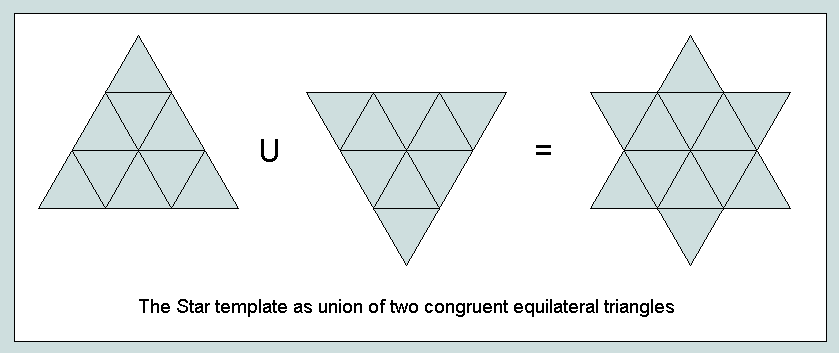
Numbered among the symmetrical features of this structure are the following - each identified by reference number:
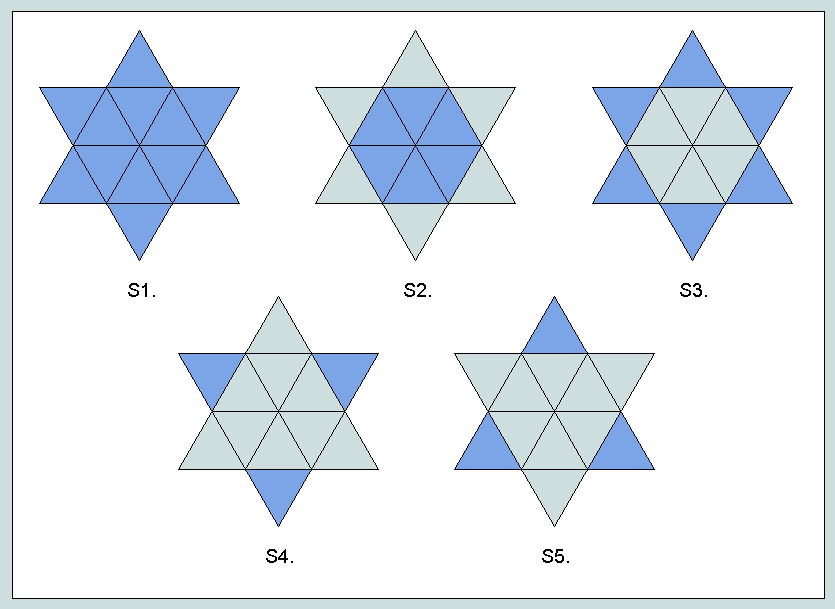
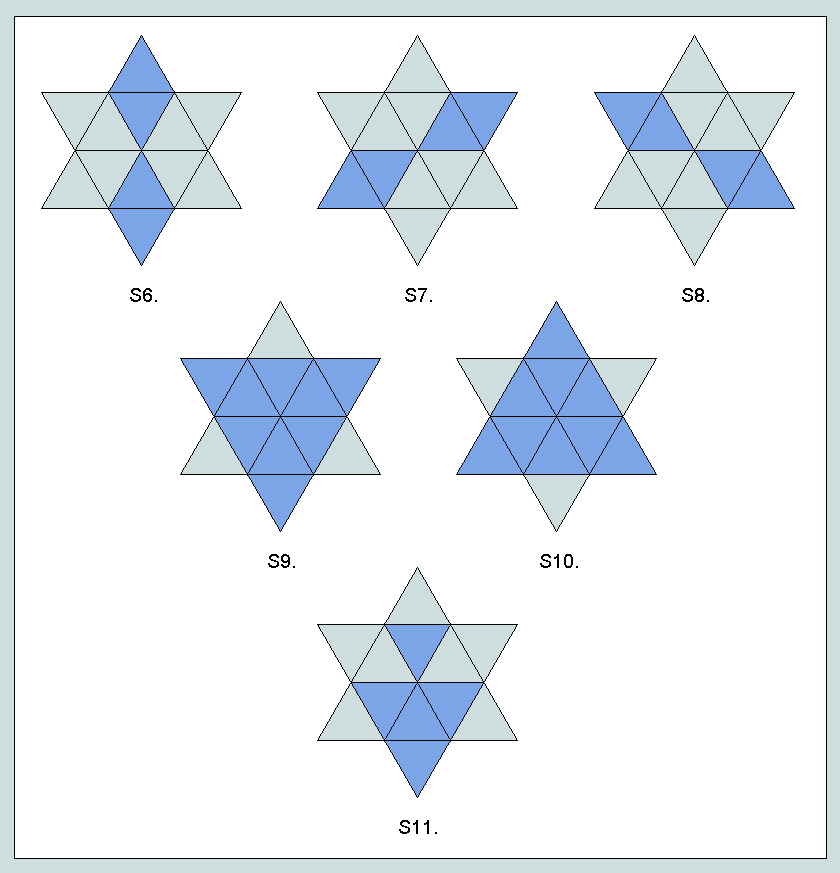
The related sums
What becomes abundantly clear is that the tribal CVs are so distributed within the confines of the Star as to exploit its symmetries. Each of these patterns is represented by the sum of the numbers contained within its elemental cells. This matter is summarised in the following table.
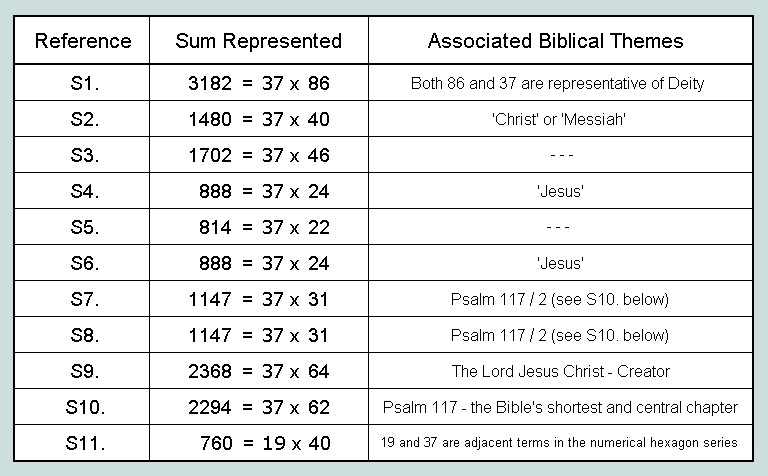
A basis for the investigation
The strategy adopted in the following computer simulations is based on the following observations:
All symmetrical patterns except the last are associated with multiples of 37; 37 - expressed as a collection of uniform counters - exhibits three distinct forms of 2-D symmetry, viz. star, hexagon and truncated square (a demonstration may be found here); expressed in similar fashion, no other number has been found to exceed, or even match, this; thus, in respect of geometrical symmetry, 37 per se is unique among the infinitude of natural numbers - and that uniqueness is clearly a distinctive feature of the Star
S11. involves the factor 19; adjacent to 37 in the hexagon series of figurate numbers and centre of 37-as-star
The complete Star, S1., has both 37 and 86 as factors; 86 is the CV of 'elohim' - the Creator God (see Genesis 1:1), and hence another name for Jesus Christ; clearly, such is the significance of each of these factors that only those sets of 12 numbers which sum to 3182 are to be regarded as acceptable samples for the purposes of this investigation
Similarly, such is the symbolic power of the central hexagon of 1480 (i.e. S2.) - representing the 'Messiah' or 'Christ' - that this also, as the sum of 6, is to be made a required feature of each sample; its complement, 1702 (i.e. S3.) then becoming the sum of the 6 spurs which complete the Star
Of these spurs, 3 of the 6 (selected on an 'every other' basis) must sum to 888 (i.e. S4.), and the complement to 814 (i.e. S5.); these combine with the central hexagon to generate 2368 (i.e. S9.) and 2294 (i.e. S10.), respectively, the resulting triangles being those whose union and intersection define the Star template; we pause to consider the connection thus established between the Creator - the Lord Jesus Christ - and Psalm 117 - the Bible's central and shortest chapter - this taking the form of a paean of praise and assurance. Here is its KJV rendering:
O Praise the LORD, all ye nations: praise him, all ye people.
For his merciful kindness is great toward us: and the truth of the LORD endureth forever.
Praise ye the LORD.
Remarkably, a further and similar link is created independently within the Star; the vertical axis, S6. of 888 is bisected by each of the equal-valued diagonals S7. and S8.; these together sum to 2294, again, the CV of Psalm 117
To meet the purposes of this investigation the foregoing conditions would appear to suffice. However, the outcome will determine whether consideration should also be given to the matter of 760 (i.e. S11.) residing symmetrically within 2368.
Simulator design: a preparatory analysis
Clearly, any pseudo-star set of 12 numbers, developed randomly for the purpose of simulating the foregoing features of the Star, must not only capture its eye-catching and symbolically-meaningful total and sub-totals, but also their symmetrical distribution within the star template. Our approach will therefore comprise two stages: the first, to isolate those sets within which the target numbers are present among the many alternative sums; the second, by generating all permutations of these specific sets, to establish whether the associated conditions of symmetry are met.
However, before we begin, there is an important matter to be settled, viz. the proper use of Visual Basic's random number generator to obtain fair samples for subsequent analysis. Here is a brief description of the approach adopted:
We observe that the numbers whose sums hold the key to our ambitions are the CVs of the 12 tribal names, here presented in ascending order:
7, 30, 46, 54, 101, 156, 162, 259, 466, 501, 570, 830
They span a range of (7 - 830) = 823, or 900, say. Clearly, the distribution is far from uniform, and to formulate an appropriate procedure for generating sets for analysis we now consider how these cluster by setting them against a background of ranges, thus:
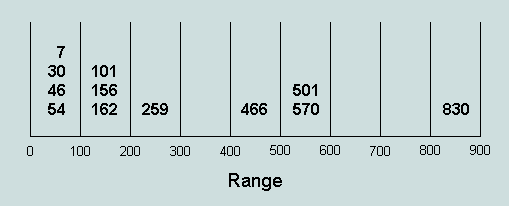
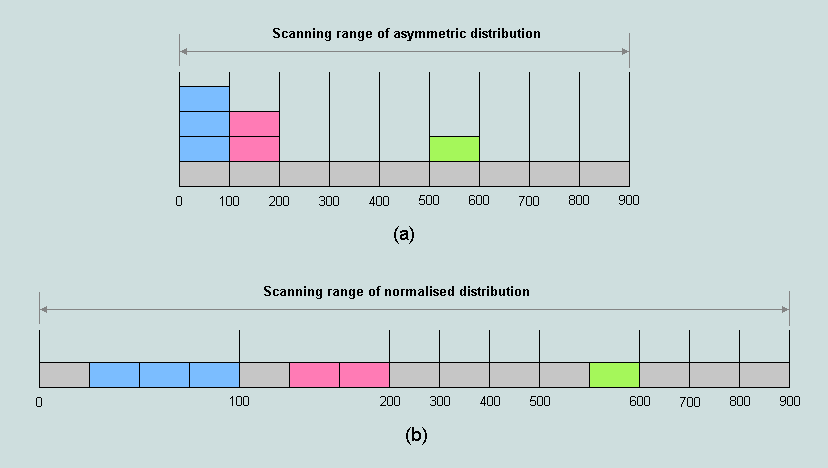
From (a), we arrive at (b) by repeating each number in the range 0 - 100 three more times; in the range 100 - 200, two more; and in the range 500 - 600, one more. This procedure clearly improves the chances of these numbers being selected when vector (b) is scanned randomly. The generator of the random numbers must therefore operate over this extended range if it is to produce 'fair' sets for our purposes.
Testing for symmetry
Such tests involve the generation of all permutations of the generated random values both within the central hexagon and the peripheral spurs. This is carried out against the following background:
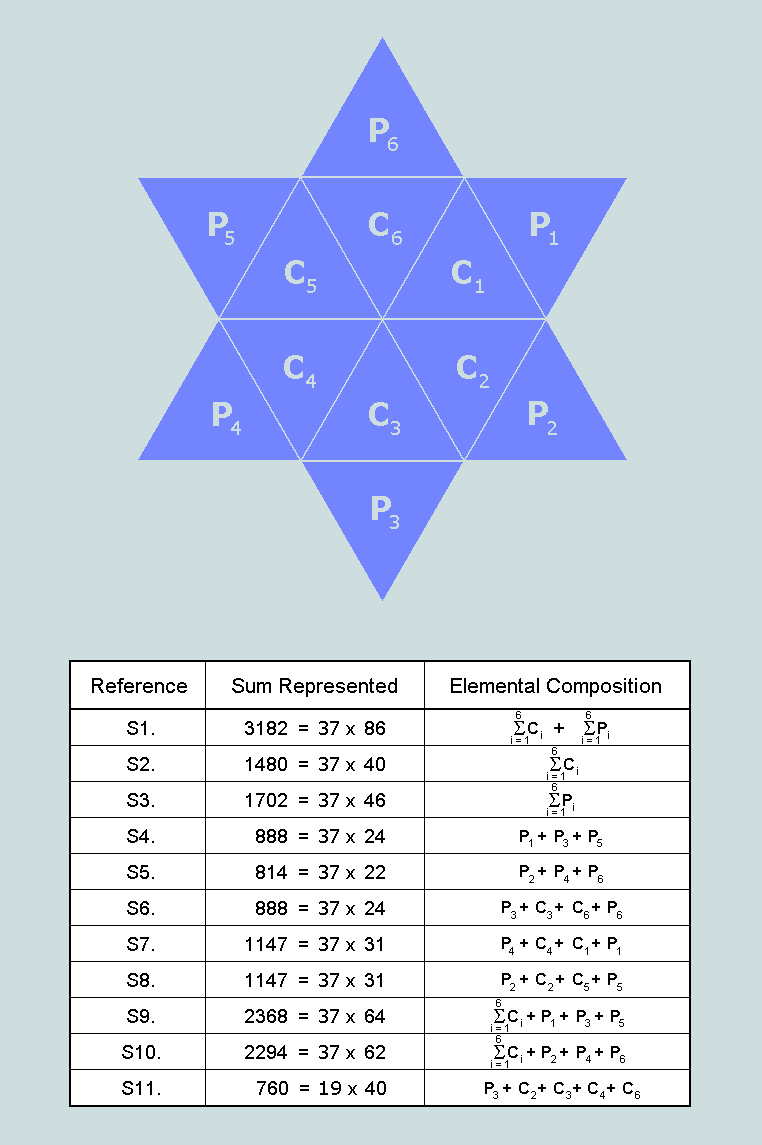
As indicated in the table above, each of the Star's symmetries may now be expressed in terms of the set of elemental triangles involved, and may thus be tested within the Visual Basic programs.
The Visual Basic programs
SI_Prog1: to generate random sets of 12 which sum to 3182, within which 6 sum to 1480, and 6 to 1702; a total of 78978 sets are thereby created in each category and stored as random-access files (SI_1.Dat, SI_2.Dat and SI_3.Dat, respectively) on the computer's hard disk.
SI_Prog2: to test disk-file SI_3.Dat for the sum 888 in three alternating spurs; output the total of sets which meet this specification.
SI_Prog3: to look for the divide 1147/888/1147 in the sets of 12 of SI_1.Dat; prepare and output a reduced folder of sets which display this property - SI_4.Dat, SI_5.Dat and SI_6.Dat, respectively.
SI_Prog4: as for SI_Prog2, but now storing the relevant sets as SI_7.Dat, SI_8.Dat and SI_9.Dat.
SI_Prog5: to test permutations of the disk file SI_4.Dat for symmetrical occurrences of the divide 1147/888/1147
SI_Prog6: to test permutations of the disk file SI_9.Dat for symmetrical occurrences of 888 in three of the outers
The computer simulation results
Here again is the proposed strategy for testing the Star's true provenance. Recollect that to be deemed 'acceptable' for our purposes each sample set of twelve random numbers must satisfy the following initial conditions:
- Sum of the 12 = 3182 = 37 x 86 - representing the complete star
- Sum of any 6 of these = 1480 = 37 x 40 - envisaged as the inner hexagon (and the remaining 6 totalling 1702 = 37 x 46, the outer spurs)
The facts:
To generate 78,978 sample sets of 12 having these characteristics involved selection from a total of 340,475,775 randomly-generated sets. In other words, 1 in every 4311 only was acceptable
The associated probability = p(1) = 2.32 x 10^(-4)
We then proceed as follows:
- Test the outer spurs component of each sample set (i.e. a subset of 6 values) for 888 as the sum of 3 alternate values (equivalent to finding the sum 814 in the remaining 3)
The facts:
78,978 subsets of 6 yielded 227 examples of the divide 888/814 in 3 alternate values.
The associated probability = p(2) = 2.87 x 10^(-3) - a figure confirmed by the symmetry analysis.
- Test for the set total (= 3182) breaking down to 1147/888/1147 - the required sums of 4 along the three axes
The facts:
78,978 sets of 12 yield just 1216 examples of this significant division of the Star. Of these, 20 met the symmetry requirement.
The associated probability = p(3) = 2.53 x 10^(-4)
Combining these probabilities, we obtain
2.32 x 2.87 x 2.53 x 10^(-11), or 1.68 x 10^(-10)
In other words, about 1 in six billion random selections meet the principal standards established in the Star
The Star is, indeed, an exceedingly rare phenomenon and is overwhelmingly likely to be the product of a purposeful, able, and fertile mind rather than a fortuitous miracle!
Vernon Jenkins MSc
2010-06-06